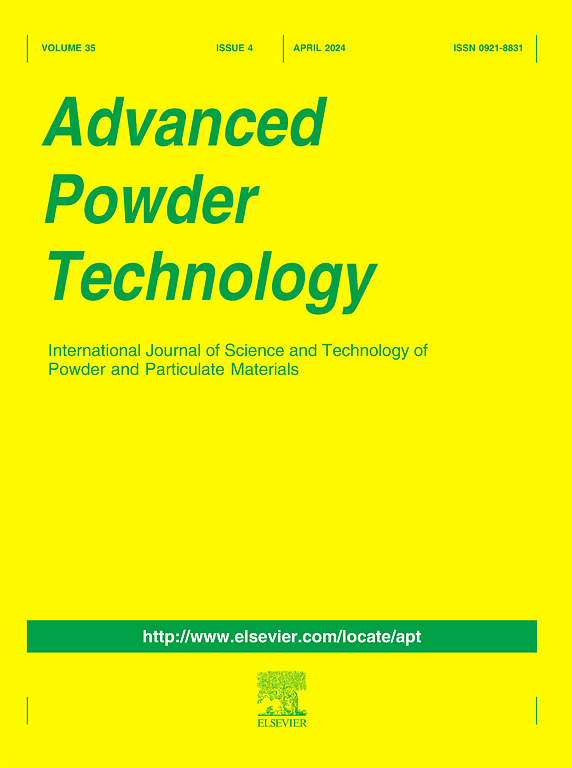Influence of additive particle content and sintering temperature on the sinterability of electrostatically assembled alumina–alumina composite particles
IF 4.2
2区 工程技术
Q2 ENGINEERING, CHEMICAL
引用次数: 0
Abstract
In this study, bimodal alumina (Al2O3) particles with average sizes of 830 nm and 140 nm were used, and an electrostatic assembly method was employed to control the formation of composite particles with varying contents of finer additive particles (140 nm), allowing the investigation of their effect on a pressureless sintering process. A homogeneous distribution of additive particles on the larger alumina core particles (830 nm) was achieved by varying the additive particle content from 12 to 40 vol%. The sinterability of the electrostatically assembled Al2O3–Al2O3 composite particles was then evaluated by sintering them at temperatures from 1300 to 1450 °C with a holding time of 5 h. The results indicated that the homogeneous distribution of the additive particles in the electrostatically assembled Al2O3–Al2O3 composite particles led to improved powder packing density and enhanced sinterability. This enabled the fabrication of denser sintered artifacts at lower sintering temperatures. These findings demonstrate that particle design using electrostatic assembly can promote a more efficient sintering process and reduce energy consumption in the fabrication of ceramic materials using powder metallurgy.

添加剂颗粒含量和烧结温度对静电组装铝-氧化铝复合颗粒烧结性能的影响
在这项研究中,使用平均尺寸为830 nm和140 nm的双峰氧化铝(Al2O3)颗粒,并采用静电组装方法来控制不同含量的更细的添加剂颗粒(140 nm)的复合颗粒的形成,从而研究它们对无压烧结过程的影响。添加剂颗粒在较大的氧化铝芯颗粒(830 nm)上均匀分布,通过改变添加剂颗粒含量从12到40 vol%实现。在1300 ~ 1450℃的烧结温度下,保温5 h,对静电组装Al2O3-Al2O3复合颗粒的烧结性能进行了评价。结果表明,添加剂颗粒在静电组装Al2O3-Al2O3复合颗粒中的均匀分布,提高了粉末的堆积密度,提高了烧结性能。这使得在较低的烧结温度下制造致密的烧结工件成为可能。这些发现表明,采用静电组装的颗粒设计可以促进更有效的烧结过程,并降低粉末冶金陶瓷材料制造的能耗。
本文章由计算机程序翻译,如有差异,请以英文原文为准。
求助全文
约1分钟内获得全文
求助全文
来源期刊

Advanced Powder Technology
工程技术-工程:化工
CiteScore
9.50
自引率
7.70%
发文量
424
审稿时长
55 days
期刊介绍:
The aim of Advanced Powder Technology is to meet the demand for an international journal that integrates all aspects of science and technology research on powder and particulate materials. The journal fulfills this purpose by publishing original research papers, rapid communications, reviews, and translated articles by prominent researchers worldwide.
The editorial work of Advanced Powder Technology, which was founded as the International Journal of the Society of Powder Technology, Japan, is now shared by distinguished board members, who operate in a unique framework designed to respond to the increasing global demand for articles on not only powder and particles, but also on various materials produced from them.
Advanced Powder Technology covers various areas, but a discussion of powder and particles is required in articles. Topics include: Production of powder and particulate materials in gases and liquids(nanoparticles, fine ceramics, pharmaceuticals, novel functional materials, etc.); Aerosol and colloidal processing; Powder and particle characterization; Dynamics and phenomena; Calculation and simulation (CFD, DEM, Monte Carlo method, population balance, etc.); Measurement and control of powder processes; Particle modification; Comminution; Powder handling and operations (storage, transport, granulation, separation, fluidization, etc.)
 求助内容:
求助内容: 应助结果提醒方式:
应助结果提醒方式:


